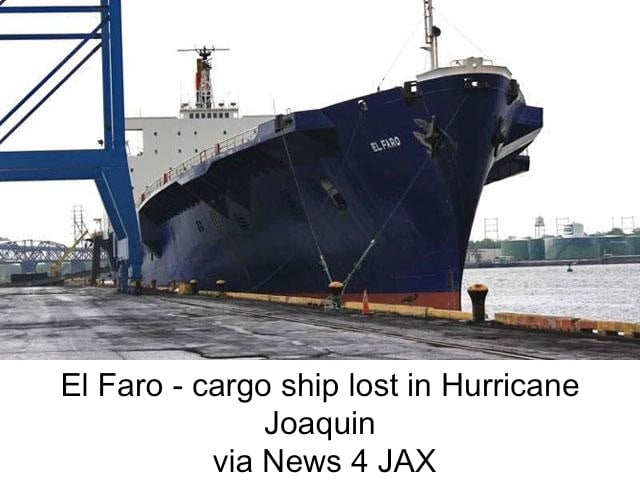
 At the beginning of October, 2015, the cargo ship El Faro was lost during Hurricane Joaquin.
At the beginning of October, 2015, the cargo ship El Faro was lost during Hurricane Joaquin.
It wasn’t until the start of November that the cargo ship’s wreckage was found on the bottom of the ocean.
Still, mystery surrounds exactly what happened to cause the ship to lose propulsion and ultimately go down, costing the lives of its 33 crew members, 28 of whom were American and 5 of whom were Polish.
That mystery is closer to being solved this week, nearly 8 months after the tragedy, as the National Transportation Safety Board (NTSB) found the El Faro’s voyage data recorder (VDR) or “black box”.
The VDR was located early Tuesday morning in 15,000 feet of water, about 41 miles (36 nautical miles) northeast of Acklins and Crooked Islands, Bahamas, by a team of investigators and scientists using remotely operated undersea search equipment.
At about 1 a.m. EDT on Tuesday morning the team aboard the research vessel Atlantis located the El Faro’s mast, where the VDR was mounted. After examining numerous images provided by undersea search equipment, the team positively identified the VDR.
15,000 feet down is close to 3 miles under water. Finding the VDR that deep is quite a feat in and of itself. But even more tricky will be retrieving the “black box”.
NBC News reports another mission will be necessary to recover the VDR:
“Now that we have been able to see just how the VDR is oriented relative to the mast structure, it’s clear that we’re going to need specialized deep-water salvage recovery equipment in order to bring it up,” Brian Curtis, acting director of the NTSB Office of Marine Safety, said in a statement Wednesday.
“Extracting a recorder capsule attached to a four-ton mast under 15,000 feet of water presents formidable challenges, but we’re going to do everything that is technically feasible to get that recorder into our lab,” he said.
The NTSB received a lot of help in locating the VDR. An article by Elizabeth Rau on Phys.org helps illuminate the teams and technology involved in finding the item that could now shed light on just what happened to the cargo ship:
Dwight F. Coleman, center director, worked closely with the National Transportation Safety Board and the Woods Hole Oceanographic Institution to install telepresence technology on the research vessel Atlantis, the Woods Hole ship that conducted the search.
“Finding an object about the size of a basketball almost 3 miles under the surface of the sea is a remarkable achievement,” said NTSB Chairman Christopher A. Hart. “It would not have been possible without the information gained during the first survey of the wreckage and the equipment and support provided by Woods Hole Oceanographic Institution, the National Science Foundation, the U.S. Coast Guard, the U.S. Navy, the University of Rhode Island, and the many other partners involved in this effort.”
Coleman said “cutting-edge telepresence technology helped provide critical clues to investigators to determine why the El Faro sank. There’s some mystery as to what happened, so finding the voyage data recorder could reveal key details about the critical moments before the sinking.”
Still, the crew members, who are all presumed dead, have not been found. This remains the greatest U.S. maritime tragedy in over 30 years.
![]()
Source: UC Blog
Discover more from reviewer4you.com
Subscribe to get the latest posts to your email.





